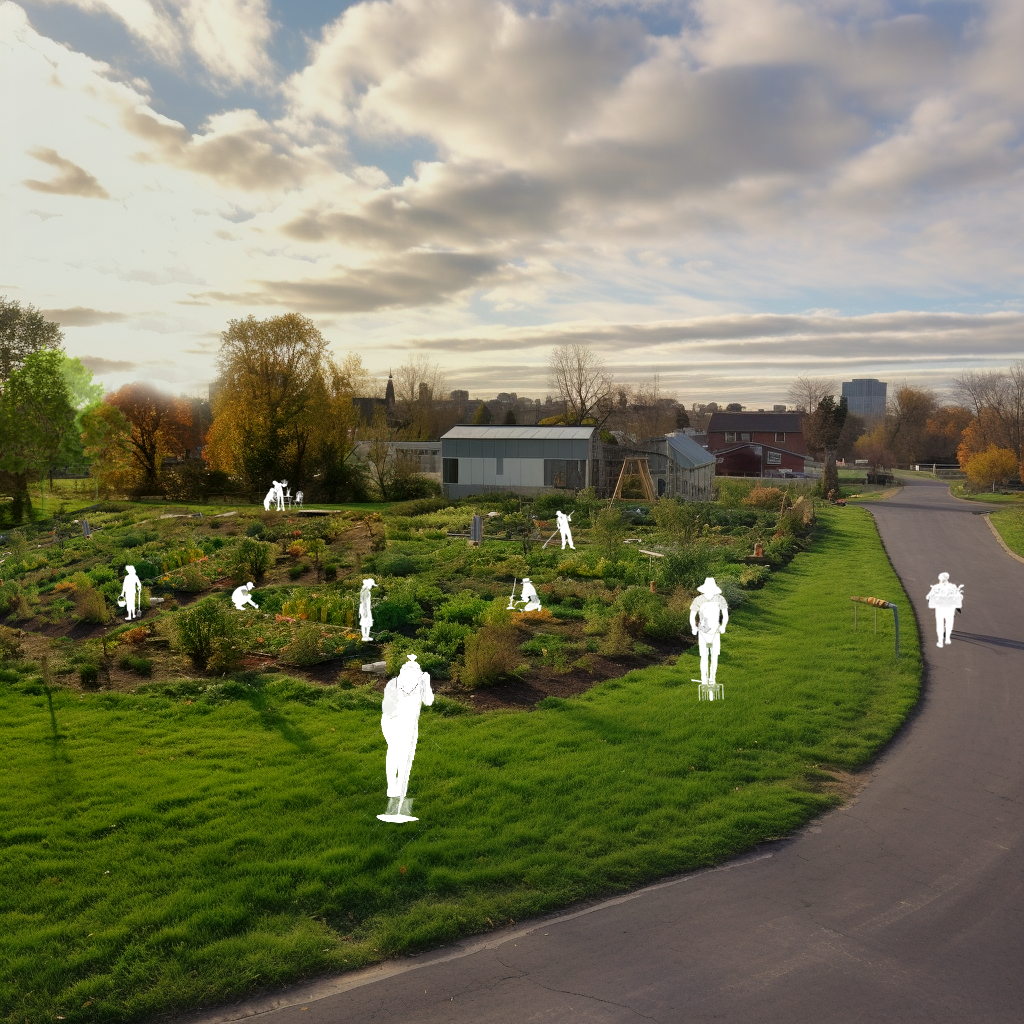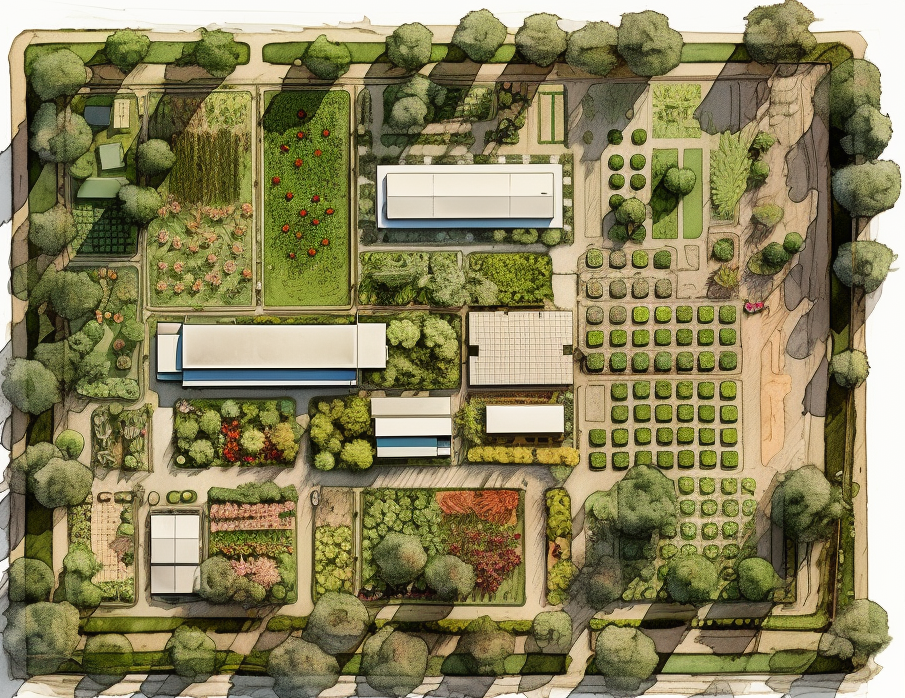︎ Interconnected Garden(s):
Aiding Brain Health through Horticulture Therapy
Retired seniors often face challenges in staying engaged and mentally active as opportunities for community activities and group interactions diminish. By fostering a peaceful and secure environment that encourages both cognitive engagement and physical movement, we can help seniors age more healthily. This setting not only promotes physical wellness but also facilitates social connections and a sense of community among the elderly.
By Ashley Yarberry ︎ , Paresh Hemnani ︎, Zehan Ge ︎,
Who
Barb, an 83-year-old woman, is currently facing the challenges of loneliness and isolation in rural Central Michigan, three hours away from her family. She is planning to relocate to Ann Arbor, Michigan. After the passing of her husband, Barb's main sources of interaction have dwindled. Her sense of connection primarily comes through sporadic iPad communications with her family, who are not frequently available, and the occasional visits from her neighbors. With limited social contact, Barb struggles with declining health which is exacerbated by her solitude. Her move to Ann Arbor represents hope for increased social interaction and community support, addressing her challenges with loneliness, isolation, and her health.
Why
The aging generation is dealing with cognitive decline due to isolation, lack of community, and mental self doubt. With the phobia against senior living, specifically assisted living, older adults are living alone much longer than what is beneficial for them. Many older adults rely on family after the death of their spouses and close friends, but are finding their children and grandchildren are living a life of their own and do not have the unlimited time to spend with them as they hope which follows with the mental battles of isolation and feelings of being a burden.
How
By intermixing groups of people and programs that are geared towards many ages and learning patterns, aging adults will feel included without feeling like a burden. Things such as gardens will use muscles in their bodies that may benefit their longevity and abilities to remain healthy and mentally happy for a longer period of time as well as their cognitive functions. Gardening games and other group activities will engage communication skills and problem solving to allow seniors to continue to provide and offer something to the community.
What
Our proposal of various scales of gardens and farms throughout the Pittsfield township community will help improve cognitive and physical conditions of the aging population starting with the first location between various popular community infrastructures. The first location will be placed directly bordering a preschool, hospice, and sports facilities that will bring different walks of life together in a space that promotes growth through gardening programs and games, as well as yoga, meditation, and spaces of outdoor therapy.
Now
To create a new program and space for Barb, who, along with her late husband, used to engage college students in landscaping and exterior house maintenance, we propose a community project in Ann Arbor, a college town. This project will involve a program where college students and the elderly collaborate on a common hobby. The initial phase includes setting up an urban garden, co-designed and maintained by local students, and involving various groups from Ann Arbor and Pittsfield Township.
The garden area will be located within existing community structures, strategically positioned between a hospice, a preschool, and a sports complex. This placement creates a unique meeting point for different community segments. Barb will be crucial in promoting this garden as a community ambassador, leveraging her social networks at her apartment complex and local community centers.
During this phase, the hospice will incorporate garden visits into its programs, offering residents nature-based therapy. The preschool will use the garden for educational and play activities, while its proximity to the sports complex provides a serene spot for athletes. This multi-faceted approach aims to establish the garden as a hub for community engagement and intergenerational wellness activities.

Near
In the second phase, our primary aim is to significantly expand the garden, enhancing both its physical space and the diversity of activities offered. This phase is marked by growth and extension, with a focus on creating diverse areas within the garden to cater to the varying interests and needs of all community members. For instance, we plan to introduce a peaceful, secluded area specifically designed for meditation and yoga, fostering a tranquil environment suitable for all ages. Another section of the garden, sunlit and vibrant, will be dedicated to therapeutic gardening. This will provide an enriching and nurturing experience for individuals of all ages to connect with nature, including special considerations for accessibility and ease of use for older participants.
This expansion phase also involves significantly broadening our program offerings, transforming the garden into a hub for new workshops focusing on community engagement. We aim to promote sustainable living and environmental education through these workshops, ensuring they are accessible and engaging for everyone. Wellness classes, such as Tai Chi and line dancing, will be adapted to accommodate the elderly and suitable for all fitness levels. Art therapy sessions and a variety of educational programs will also be introduced, covering topics from local flora and fauna to composting and organic gardening techniques. Our goal in this phase is to transform the garden into a space that is not only more inclusive but also diverse and educational, serving as a valuable resource to support positive aging for senior members and the entire community.
In the second phase, our primary aim is to significantly expand the garden, enhancing both its physical space and the diversity of activities offered. This phase is marked by growth and extension, with a focus on creating diverse areas within the garden to cater to the varying interests and needs of all community members. For instance, we plan to introduce a peaceful, secluded area specifically designed for meditation and yoga, fostering a tranquil environment suitable for all ages. Another section of the garden, sunlit and vibrant, will be dedicated to therapeutic gardening. This will provide an enriching and nurturing experience for individuals of all ages to connect with nature, including special considerations for accessibility and ease of use for older participants.
This expansion phase also involves significantly broadening our program offerings, transforming the garden into a hub for new workshops focusing on community engagement. We aim to promote sustainable living and environmental education through these workshops, ensuring they are accessible and engaging for everyone. Wellness classes, such as Tai Chi and line dancing, will be adapted to accommodate the elderly and suitable for all fitness levels. Art therapy sessions and a variety of educational programs will also be introduced, covering topics from local flora and fauna to composting and organic gardening techniques. Our goal in this phase is to transform the garden into a space that is not only more inclusive but also diverse and educational, serving as a valuable resource to support positive aging for senior members and the entire community.
Far
In the third phase of our proposal, we aim to seamlessly integrate existing and future infrastructures within the community by establishing pocket parks near essential areas like healthcare facilities, libraries, local businesses, bus stops, and transportation hubs. These parks will be interconnected through a vast network of community gardens, spreading across the neighborhood to offer flexible engagement opportunities tailored to individual schedules and interests. Additionally, to counter Ann Arbor's extended colder months, we plan to establish greenhouse spaces for year-round programming, ensuring that these green spaces are not only accessible but also functional throughout the year, enhancing community well-being and environmental consciousness.
In the third phase of our proposal, we aim to seamlessly integrate existing and future infrastructures within the community by establishing pocket parks near essential areas like healthcare facilities, libraries, local businesses, bus stops, and transportation hubs. These parks will be interconnected through a vast network of community gardens, spreading across the neighborhood to offer flexible engagement opportunities tailored to individual schedules and interests. Additionally, to counter Ann Arbor's extended colder months, we plan to establish greenhouse spaces for year-round programming, ensuring that these green spaces are not only accessible but also functional throughout the year, enhancing community well-being and environmental consciousness.
So What
By creating these spaces of interaction in the community, interconnections are made through different ages of people, different mental and physical strengths, different backgrounds, and most importantly different stages of life. These environments will benefit everyone but most importantly the aging population that is slowly moving farther away from the "general public" or more relevant generation of society at any given time. It will help connect these different groups and possibly help both groups out through community engagement within one another.



Design To Outcomes
Our proposal aims to create a comfortable, inclusive environment for Barb and others in the community, fostering interaction, exercise, and mental resilience. We offer programs tailored to different strength levels and abilities, suitable for all age groups. Our goal is to enhance mental and physical health, mood, community bonds, and overall well-being.
In designing for Barb, we've considered pedestrian-friendly street layouts, rest areas for comfortable walks, and programs encouraging socialization. We aim for inclusivity and easy access to these amenities, ideally near Barb's daily routine locations.
We propose gardening and horticultural therapy as a solution to these design challenges. It offers physical benefits like improved strength, flexibility, reduced stroke and heart disease risks, and obesity prevention. Mentally, it can uplift mood, enhance well-being, and lower stress levels.

Site Plan of the proposed garden
Links to Follow:
︎︎︎Two Page Report
︎
Works Cited
-
Chalmin-Pui, L., Griffiths, A., & Roe, J. (2020, August). Why garden? – attitudes and the perceived health benefits of home gardening. https://www.researchgate.net/publication/349197586_Why_garden_-_Attitudes_and_the_perceived_health_benefits_of_home_gardening
-
Detweiler, M. B., Sharma, T., Detweiler, J. G., Murphy, P. F., Lane, S., Carman, J., Chudhary, A. S., Halling, M. H., & Kim, K. Y. (2012, June). What is the evidence to support the use of therapeutic gardens for the elderly?. Psychiatry investigation. https://www.ncbi.nlm.nih.gov/pmc/articles/PMC3372556/
-
Park, S.-A., Lee, A.-Y., Park, H.-G., & Lee, W.-L. (2019). Benefits of gardening activities for cognitive function according to measurement of brain nerve growth factor levels. International Journal of Environmental Research and Public Health, 16(5), 760. https://doi.org/10.3390/ijerph16050760
-
Rodiek, Susan. (2002). Influence of an outdoor garden on mood and stress in older adults. Journal of Therapeutic Horticulture. XIII. 13-21.
-
Rebecca Briggs, Paul Graham Morris & Karen Rees. (2023) The effectiveness of group-based gardening interventions for improving wellbeing and reducing symptoms of mental ill-health in adults: a systematic review and meta-analysis. Journal of Mental Health 32:4, pages 787-804.
-
Scott, T. L., Masser, B. M., & Pachana, N. A. (2020, January 22). Positive aging benefits of home and community gardening activities: Older adults report enhanced self-esteem, productive endeavors, social engagement and exercise. SAGE open medicine.
-
Shu Lin Shi, Chau Ming Tong & Yi Qi Tao (2018). How does spatial organization of gardens at care facilities for the elderly influence use patterns: a case study in Hong Kong, Landscape Research, 43:1, 124-138, DOI: 10.1080/01426397.2017.1305345.
-
Wang, D., & MacMillan, T. (2013). The benefits of gardening for older adults: A systematic review of the literature. Activities, Adaptation & Aging, 37(2), 153–181. https://doi.org/10.1080/01924788.2013.784942